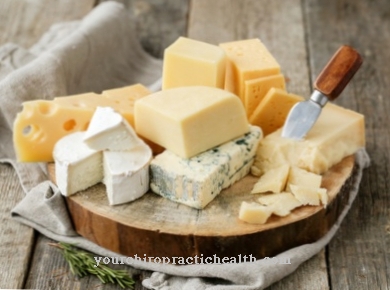Capers come from the real caper bush in the Mediterranean area. We also use them as a spicy food ingredient. They also play a role in healthcare.
What you should know about capers

Capers are the buds of the real or thorny caper bush (Capparis spinosa), which grows in the dry and warm regions of the Mediterranean. Southern France and the Aeolian Islands are the main suppliers of the small buds.
The shrub has branches up to four meters long with oval, thick leaves, some of which develop into thorns. The flowers arise in the axes of the branches and are harvested in spring before they bloom. Machines are not used here. Then they have to dry for a day - the manufacturers call them wilting - and are then placed in vinegar, salt or oil for later consumption. This creates mustard oil glycosides and capric acid, which create the piquant taste. It ranges from tangy to spicy. The buds are not edible raw. The bigger they are, the more intense they taste.
The French prefer the very small, very mild varieties and call them Nonpereilles (the incomparable ones). They are four to seven millimeters in size. The seven-level division extends to the Hors Caliber with a size of 13 to 15 millimeters. Both the untreated and the pickled buds have the olive green color. In Spain, the capers with a size of about two centimeters are also known as a side dish or as tapas. In Rhodes, Cyprus and Santorini, even the leaves of the caper bush are used in gastronomy.
Fruits and leaves are inlaid like the buds. In Germany, the trade also stocks caper substitutes. These buds come from the marsh marigold, celandine or nasturtium. Real capers have a long tradition in gastronomy. The earliest evidence comes from the Early Bronze Age in Jordan. The Greeks and Romans also used them in the kitchen, but also as aphrodisiacs. In the Old Testament the caper symbolizes the transience of the world, probably because of the short flowering period.
Importance to health
Because of the high content of antioxidants, capers are considered a remedy for heart disease and even cancer. They can neutralize the harmful by-products that result from the digestion of animal fats. At the same time, the inlaid buds develop their preventive effect. They are also used in cosmetics.
The applied extract or leaves give the skin freshness and smooth wrinkles. In addition, the capers are appetizing, digestive and dehydrating. In the case of edema of pregnancy and the vascular disease purpura, consumption has been shown to be helpful. Avoiding loss of appetite plays a major role in convalescence and debilitating therapies. While the doctors of antiquity prescribed capers to cure spleen diseases, medicine in various countries today uses them to combat rheumatism and arthritis.
Iran sees the small buds as an efficient remedy for high blood sugar levels. The mustard oils contained in the capers as well as the flavors rutin and quercitin are considered to be vascular strengthening, antispasmodic and anti-inflammatory. Thus, capers protect against infectious diseases. Ayurvedic medicine also makes use of this. She uses caper extract as an anti-carcinogen and for hepatitis.
Ingredients & nutritional values
| Nutritional information | Amount per 100 gram |
| Calories 23 | Fat content 0.9 g |
| cholesterol 0 mg | sodium 2,769 mg |
| potassium 40 mg | carbohydrates 4.9 g |
| Fiber 3.2 g | protein 2.4 g |
Capers are healthy and low in calories. 100 grams of the low-fat raw material contain only 23 calories. They consist of 85.2 percent water; the only carbohydrate present is glycogen, 2.66 grams. Capers are therefore also digestible for diabetics. They only have 0.2 bread units per 100 grams of untreated buds.
The fat content is also very low at 0.9 grams. On the other hand, the small buds of 2.4 grams have a lot of protein compared to other types of fruit and vegetables. Although capers are used for scurvy in some countries, they do not contain many vitamins. B2 and B6 as well as folic acid and a-tocopherol are present in significant amounts, beta-carotene and niacin equivalent only in the microgram range.
Intolerances & allergies
Capers as such are well tolerated. However, the respective treatment methods can promote intolerance. The pickled buds are therefore unsuitable for people with a histamine intolerance. You should switch to capers in brine.
People with unspecific problems in the digestive tract often follow the basic gastroenterological diet. This is the light whole food. The patient has to forego various foods that cause intolerance in more than five percent of cases. Although it does not mean therapy, it can alleviate the symptoms. In these cases, capers should also be avoided.
Shopping & kitchen tips
Capers are available from us all year round. Delicatessen stores, health food stores and supermarkets keep them in small glasses. Most of the time, the small buds are placed in a mixture of vinegar and oil, in rare cases also in brine.
This variant is mainly found in gourmet shops and in specialty shops owned by Turks and Italians. They even have capers made of dry sea salt. The Mediterranean see this variant as the only real one, because the taste is almost unadulterated. We use the buds only as a spice and not as a side dish.
For this reason, most recipes only call for a small amount of capers. Correct storage therefore plays an important role. Stored in the refrigerator, they can usually be consumed for a year or more after opening the jar. This time can be extended by adding a little oil to the liquid. However, the buds must always be completely covered with brew.
Capers pickled in brine are already fully preserved by the sodium chloride and have a particularly long shelf life. However the capers are canned, they should be rinsed or even watered well before consumption. Otherwise too much vinegar or salt will be transferred to the dish and spoil the taste. The water can be used later for cooking pasta.
Preparation tips
The classic cuisine for using capers in this country are Königsberger Klopse. The tender meat tolerates the tart, spicy taste very well. In addition, the buds go well with all dishes that tolerate a fine acidity. They are almost always found in cold sauces.
The buds are also popular with hard-boiled eggs, potato salad and tartare. Those who like the particularly intense caper taste opt for the larger varieties. Then it makes sense to cut them into small pieces before consuming. In the meantime, more daring recipes have established themselves. A refreshing drink can be made from natural yoghurt with capers, milk and a little lemon.
























.jpg)



